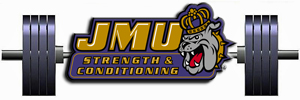 Official
Site of the James Madison University Strength & Conditioning Program Official
Site of the James Madison University Strength & Conditioning Program |
|
|
|
Effectiveness of Complex Training Review performed by Elliott White, JMU Strength & Conditioning Intern In most sports, the ability to generate maximal muscular force in the shortest time possible is imperative to success. This force is also called muscular power. Two main methods of training have been proven to improve explosive strength in athletes: resistance training and plyometric training. There is also a third method, known as complex training, that seeks to combine both these methods. Complex training consists of a resistance exercise followed by either a plyometric exercise, or a lighter resistance exercise (Santos, 2008). Santos and Janeira developed a study to determine the effectiveness of this training regiment in improving upper and lower body explosive strength. The Effects of Complex Training on Explosive Strength in Adolescent Male Basketball Players gathered 25 male athletes aged 14-15 and assessed their skills in the squat jump, countermovement jump, Abalakov test, depth jump, mechanical power, and medicine ball throw, prior to a ten week training program. The control group maintained regular practice sessions but withheld from any strength or plyometric training. The experimental group maintained regular practices in addition to two sessions per week of complex training, with an average rest of 4 minutes between resistance and plyometric exercise (Santos, 2008). More strength conditioning training is needed during sports practice season for these particular athletes because the control group significantly decreased values in the countermovement jump, Abalakov test, and mechanical power. The experimental group showed significant increases in the squat jump, countermovement jump, Abalakov test, and in mechanical power (Santos, 2008). Other studies, including those by Zepeda and Gonzalez, and Burger et al., have examined the effectiveness of complex training. Pre and Post test results by Zepeda and Gonzalez on 7 Division I college basketball players showed improvements in events such as 300m shuttle, 1 mile run, 20 yard dash, back squat and pro-agility (Zepeda, 200). Burger et al. conducted a study on 78 Division I college football players and demonstrated improvement in bench press, squat, power clean, medicine ball throw, broad jump and vertical jump after a 7 week regiment of complex training (Burger, 2000). Based on these findings, it can be concluded that complex training is indeed effective in improving upper and lower body explosiveness in young basketball players. Complex training is effective in increasing vertical jump power because it stimulates the nervous system resulting in the availability of more Type IIb fibers for use in explosive exercises. Resistance training increases motor neuron excitability and reflex potentiation, which may lead to better training conditions for subsequent plyometric exercises (Santos, 2008). When correctly designed this program carries no extra workload on adolescents, as indicated by the lack of any injuries to the young subjects. As suggested by the literature, the use of both resistance and plyometric training in the same workout is an effective strategy of time management and for improvements in explosive power. Reference: Burger, T., Boyer-Kendrick, T. and Dolny, D. (2000) Complex training compared to a combined weight training and plyometric training program. Journal of Strength and Conditioning Research 14(3), 360. Santos, E. (2008). Effects of Complex Training on Explosive Strength in Adolescent Male Basketball Players. Journal of Strength and Conditioning Research, 22-3, 903-909. Zepeda, P. and Gonzalez, J. (2000) Complex training: Three weeks pre-season conditioning in division I female basketball players. Journal of Strength and Conditioning Research 14(3), 372.
|
|
Number of visitors since 9/15/04
This is the official website of the James Madison University Strength & Conditioning program. Please direct any comments or questions to Greg Werner, Director of Strength & Conditioning. Date this site was last updated 01/06/2009 08:53:51 PM |